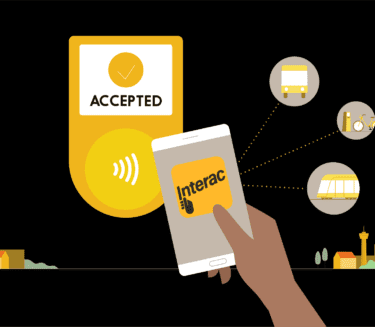Interac survey reveals more than two-thirds of Canadians believe contactless payments would make paying for transit quicker and more convenient
As Canadians transition into a post-pandemic future, Interac sought to shed light on shifting transportation habits and the role payment methods have on their behaviour. What follows is a Q&A with Andrew Yablonovsky, Associate Vice President, Product Strategy & Growth at Interac, with insights from a survey commissioned by Interac in August 2022 on the role contactless forms of payment can have in shaping how Canadians use public transit.
What did the survey tell you about the trends we are seeing in public transit usage?
The main finding we took away from this survey was that removing access barriers and points of friction for riders is key to encouraging more people to use transit post-pandemic. Nearly seven in ten Canadians (68 per cent) said contactless payments – where riders can pay their fare with the tap of their debit or credit card – would make paying for transit quicker and more convenient. Over a third (37 per cent) also said having a dedicated transit card or app is inconvenient, further highlighting the need for new payment options where the rider can pay their fare without using tokens, tickets or passes.
Why is now such an important time to implement contactless payments?
The consumer experience needs to become more seamless if we are to entice people to use transit. Right now, transit is seeing a slow post-pandemic recovery with daily ridership having dropped by approximately 44 per cent since the COVID-19 pandemic. This can have consequences for our economy since it stands to benefit from greater transit ridership. Our survey results also show that over half of Canadians (52 per cent) view transit use as important for economic recovery.
For example, looking at ways we could make our cities more welcoming to tourism – a key economic sector – seven in 10 Canadians (69 per cent) believe it would be easier for visitors to pay for transit using their bank card as opposed to tickets, tokens or passes. The way we approach payments can help contribute to creating cities that are more welcoming to visitors from across Canada.
What is debit’s role in contactless payments for transit?
Contactless payments reduce fare friction by removing the obstacle of obtaining and loading dedicated transit passes on an ongoing basis. Further, having different payment options means riders have more control and choice over how they pay for their trips. We have an opportunity to prioritize payment options which allow commuters to stay in control. Interac® Debit has an important role to play in making the future of transit more inclusive for Canadians who don’t have access to credit or want to be flexible in how they pay for their trips.
Our study also shows that Canadians rely on their bank cards. More than eight in 10 Canadians (83 per cent) bring these with them whenever they leave home. Two thirds of transit users (67 per cent) also indicated they would be likely to pay for transit by tapping their debit or credit card, if the option was available.
What sort of work has Interac done towards implementing contactless payments for transit?
Interac is working within the transit ecosystem to support the introduction of contactless debit payments as we believe offering riders more payment choices will encourage further usage of public transit. In March of 2021, we announced a partnership with Moneris, which became the first acquirer in Canada to process Interac Debit for open loop transit payments. Interac Debit is also now accepted on UP Express in Toronto, offering riders a contactless payment option, and Translink in Metro Vancouver will enable Interac Debit into that network’s payment system soon.
You’ve referenced some of the national results from the survey. Did anything stand out on a regional basis?
One aspect of the results that stood out is the appetite within various regions for forms of contactless payment. For example, the desire for contactless forms of payment was highest in Alberta and Quebec, where just under three-quarters of respondents in those provinces (74 per cent and 73 per cent respectively) expressed a likelihood to use payments with debit and credit on public transit. In Ontario and Atlantic Canada, that number was almost seven in 10 (68 per cent and 69 per cent respectively). So, the prospect of paying for transit via tap is not completely new or foreign to Canadians.
To read more about Interac’s transit study, click here.
About the survey
Hill+Knowlton Strategies used the Leger Opinion online panel to survey 2,343 Canadians over the period of August 9th to 16th, 2022. Sampling was done within age, gender, and region quotas. The length of survey was less than 10 minutes. Data was weighted on age, gender, and region according to 2016 census figures. An associated margin of error for a randomly selected sample of n=2,343 would be ±2.1%, 19 times out of 20.





